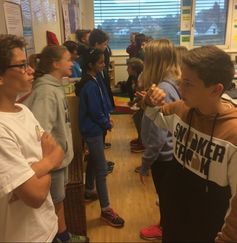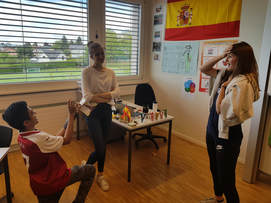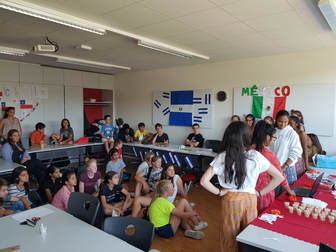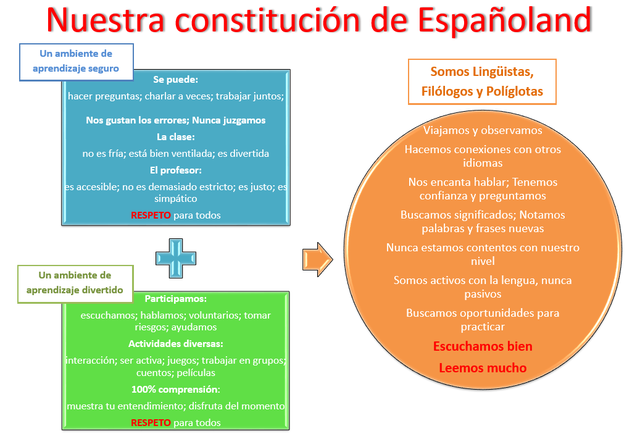The three core tenets of quality classroom management are: Clear expectations, Consistent routines and Strong relationships. The ‘Class Constitution’ hits all of these. It usually takes a full double period (for me that is 80 minutes) to do it properly. Dedicating a full class to this may seem like a lot but it is the best time investment you will spend all year and will save you hours and hours in the long run whilst also keeping you as that happy, enthusiastic and motivated teacher you want to be all year.
 Building relationships results in more eager and engaged students
Building relationships results in more eager and engaged students As students arrive on the first day, greet them at the door with care and respect, looking them in the eye. As they take their seats I tell them they are all no longer in school but in the ‘Embajada de Españoland’ (Embassy of Españoland). I bring them to the door and show them my 'border' (black tape on the ground and something we use a lot later on when talking about migration) and ask them to explain what they know about ‘borders’ and ‘embassies’ to me. For my total beginner students I tell them that normally in Españoland we only speak Spanish but just for today we will be doing everything in English. Yes, I know this is valuable time when they could be getting more input but in my experience, showing the students that this is important enough for a full double lesson sets us up for the year and allows me to have much more time giving them Comprehensible Input throughout the year as they are totally bought-into the process. With all other year groups/levels we do it in Spanish but I allow responses and group talk in English that I will translate for them.
In small groups of three or four, students firstly have some quiet thinking time and then they chat about what a 'safe classroom' means to them. On large sheets of paper, they start jotting down ideas. You can do this in whatever way works for you but I usually have one big A3 piece of paper on each table, for every group, and it is divided into three sections. Each group writes their ideas in one section of their paper with the heading “safe”.
Step 2: Teacher led discussion
After 5 minutes (or less if you wish), I ask each group for some ideas or key words they wrote down. I jot these on the board, making sure to recognize any great words or concepts that come out. Obviously though, you, as the teacher, are a skilled practitioner and professional, so you keep probing for answers until they come up with what you really want to hear. Students will quickly realise that while silly or immature words are listened to but not accepted, the teacher gets very enthusiastic and excited about concepts like ‘respect, listening, we love mistakes’ etc.
 Having fun as part of our constitution equals more engagement
Having fun as part of our constitution equals more engagement The above two steps are now copied in the same way but changing the focus to ‘fun’. I usually have each group move to a different table so they can see the words and answers that other groups wrote down. They can add some words if they wish. In the discussion part for this question you will see the enormous impact of the tone you set and the way you looked in their eyes and smiled when they gave you a great word in the first discussion. You will start getting really great stuff here right from the outset. Again, use your skills to facilitate a discussion until those key concepts start to surface.
Step 4: What does it mean to be 'linguist'?
The final section of their paper is about being a linguist. I introduced this last September and it worked wonders as a classroom management piece throughout the year. They follow the same procedure as before but you may need to explain what a ‘linguist’ is. I tell them that by being citizens of Españoland they are all now part of a very elite and special group, they are no longer mere students or learners but linguists. Just watch their faces light up as you call them ‘linguists’. When we get to the group discussion part, I explain that we as linguists, are different, we do not act like everyone else. What do we do that is different? After some probing, they will come out with things like “we respect other cultures, we listen to other languages, we read and inquire into cultural differences, we love speaking languages, we love listening to others talk in a different language” etc. This simple element of naming them for the whole year as linguists has a profound impact on behaviour, attitude and confidence.
 Respect for the constitution allows for effective group activities
Respect for the constitution allows for effective group activities Once we have all our key ideas on the board under our three headings, I ask them what they notice. Someone will point out the word ‘respect’ has magically appeared in all three areas so this must be the centre and core of our constitution. We then circle and highlight other ‘big ideas’ or key concepts together. Finally, I ask them if it would be ok if I could represent them and pool all of this together into our very own constitution. I also ask them, “if we have an embassy based on these ideas do you think it will be a good year in Españoland?”, they inevitably will answer yes. I also explicitly point out and say that they did not walk in here and get handed a list of ‘my’ rules of the class. Instead, they wrote their own constitution, they came up with the key values and concepts of being a citizen of Españoland themselves.
Step 6: The next class
I start the next class by showing them their constitution… it is no surprise that all my classes have a constitution that is almost identical. I ask them if I have represented their ideas adequately and if they are happy that this be our ‘guiding document and principles’ for life in Españoland. There is also great cross-curricular learning here with Humanities; I often have the younger students speak to their humanities teacher about our constitution and allow them to show off that they know what it is and why it is important to countries and citizens to have one.
The constitution remains on our ‘embassy’ wall for the year. If there are any lapses in behavior or standards that we all expect from each other, I simply bring the student(s) in question to the constitution and point to the requisite section and smile. This usually does the trick but sometimes I might have to remind the entire class of our underlying constitutional values that they themselves designed and wrote. These lapses in standards are actually incredibly rare. In general, co-creating the shared ideals together results in a respectful classroom where everyone feels safe, where we have fun, where we act like the linguists we are and where we thrive upon our favourite mistakes as unique learning opportunities. I always remind students that “as linguists, we are special, we are unique, we listen intently to understand and therefore learn”. Simply changing the discourse and calling them linguists possesses some magical power to keep everyone engaged, enthused and eager to represent themselves as the linguist they are.
As my regular blog followers will already know, the thesis for my Doctor of Education studies is focused on strategies that motivate both the teacher and student in the language classroom. Specifically, I am looking at Ryan and Deci’s (2000) Self-Determination Theory relating to intrinsic motivation. It posits that when activities meet the three basic psychological needs of autonomy, relatedness and competence, this results in intrinsic motivation; where we engage in something out of pure joy and interest rather than external forces acting upon us. This forms the backbone of all my classroom planning as, in my opinion, motivated students who like the class and want to be there, who want to listen and learn, make for great language learners. The ‘Class Constitution’ meets all of the three psychological needs of Self-Determination Theory:
- Autonomy: Students are co-creating this constitution themselves with the teacher; they have control, choice and ownership over what to suggest and what is ultimately included.
- Relatedness: Through building the ‘Class Constitution’ together in groups and then with me as the teacher, they are fostering strong bonds and relationships both to each other, to the teacher and to 'Españoland' itself.
- Competence: When the teacher acknowledges the students' ideas and then accepts their concepts as important enough to go into the constitution, the students feel ‘able’ for what is being asked, they feel competent.


 RSS Feed
RSS Feed